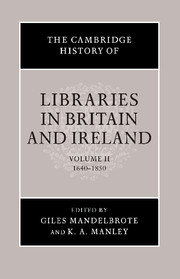Book contents
- Frontmatter
- 1 Introduction: the changing world of libraries – from cloister to hearth
- PART ONE THE EXPANSION OF BOOK COLLECTIONS 1640–1750
- 2 Ancients and moderns: cross-currents in early modern intellectual life
- 3 Libraries, books and learning, from bacon to the enlightenment
- 4 Opportunities for building collections and libraries
- 5 Libraries for school education and personal devotion
- 6 Libraries for the parish: individual donors and charitable societies
- 7 Endowed libraries for towns
- 8 Libraries in university towns
- 9 Ecclesiastical libraries: libraries for the higher clergy
- 10 Libraries for antiquaries and heralds
- 11 Professional collections: libraries for scientists and doctors
- 12 Personal owners of books
- 13 Library buildings and fittings
- 14 Baroque librarianship
- PART TWO LIBRARY DEVELOPMENT AT A LOCAL LEVEL
- PART THREE PROVINCIAL AND METROPOLITAN LIBRARIES 1750–1850
- Select bibliography
- Index
- References
13 - Library buildings and fittings
from PART ONE - THE EXPANSION OF BOOK COLLECTIONS 1640–1750
Published online by Cambridge University Press: 28 March 2008
- Frontmatter
- 1 Introduction: the changing world of libraries – from cloister to hearth
- PART ONE THE EXPANSION OF BOOK COLLECTIONS 1640–1750
- 2 Ancients and moderns: cross-currents in early modern intellectual life
- 3 Libraries, books and learning, from bacon to the enlightenment
- 4 Opportunities for building collections and libraries
- 5 Libraries for school education and personal devotion
- 6 Libraries for the parish: individual donors and charitable societies
- 7 Endowed libraries for towns
- 8 Libraries in university towns
- 9 Ecclesiastical libraries: libraries for the higher clergy
- 10 Libraries for antiquaries and heralds
- 11 Professional collections: libraries for scientists and doctors
- 12 Personal owners of books
- 13 Library buildings and fittings
- 14 Baroque librarianship
- PART TWO LIBRARY DEVELOPMENT AT A LOCAL LEVEL
- PART THREE PROVINCIAL AND METROPOLITAN LIBRARIES 1750–1850
- Select bibliography
- Index
- References
Summary
The enormous increase in the number of printed books during the sixteenth century eventually forced complete redesigning of library buildings and furnishings throughout Europe. In Britain this transformation took place over a long period, from the 1590s to the early eighteenth century. It was not until the 1750s that library buildings came into use in England and Ireland which fully reflected what had been achieved a century and a half earlier in the principal Counter-Reformation libraries, Sixtus V’s Vatican Library in Rome (opened 1587), Philip II’s palace library at the Escorial (c. 1567–84) and the great library built for Cardinal Federigo Borromeo in 1603–9, the Ambrosiana in Milan.
Traditionally libraries had been fitted to provide individually lit spaces for readers seated at desks to which manuscripts, and later printed books, were chained. Library rooms were therefore normally long and narrow, lit on both sides by small windows set low down to provide focused lighting for the sloping desk tops on which the chained books were read. General lighting could be provided, if at all, only by a larger window in an end wall.
The grandiose new libraries of Italy and Spain were in every way different. Their contents could be counted not in the low hundreds but in the many thousands. Books were shelved against the walls, not fixed by chains but protected by wire guard-doors and accessed from higher shelves by means of galleries. Lighting was general, not focused, from windows set high up the walls or in a clerestory under a vaulted ceiling.
- Type
- Chapter
- Information
- The Cambridge History of Libraries in Britain and Ireland , pp. 190 - 211Publisher: Cambridge University PressPrint publication year: 2006



